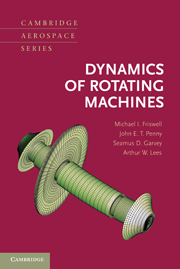Book contents
- Frontmatter
- Contents
- Preface
- Acronyms
- 1 Introduction
- 2 Introduction to Vibration Analysis
- 3 Free Lateral Response of Simple Rotor Models
- 4 Finite Element Modeling
- 5 Free Lateral Response of Complex Systems
- 6 Forced Lateral Response and Critical Speeds
- 7 Asymmetric Rotors and Other Sources of Instability
- 8 Balancing
- 9 Axial and Torsional Vibration
- 10 More Complex Rotordynamic Models
- Solutions to Problems
- Appendix 1 Properties of Solids
- Appendix 2 Stiffness and Mass Coefficients for Certain Beam Systems
- Appendix 3 Torsional Constants for Shaft Sections
- Bibliography
- Index
8 - Balancing
Published online by Cambridge University Press: 05 February 2015
- Frontmatter
- Contents
- Preface
- Acronyms
- 1 Introduction
- 2 Introduction to Vibration Analysis
- 3 Free Lateral Response of Simple Rotor Models
- 4 Finite Element Modeling
- 5 Free Lateral Response of Complex Systems
- 6 Forced Lateral Response and Critical Speeds
- 7 Asymmetric Rotors and Other Sources of Instability
- 8 Balancing
- 9 Axial and Torsional Vibration
- 10 More Complex Rotordynamic Models
- Solutions to Problems
- Appendix 1 Properties of Solids
- Appendix 2 Stiffness and Mass Coefficients for Certain Beam Systems
- Appendix 3 Torsional Constants for Shaft Sections
- Bibliography
- Index
Summary
Introduction
In all rotating machinery, some degree of mass unbalance is always present. Chapter 6 shows that small deviations in mass symmetry about the axis of rotation can lead to significant unbalance forces being exerted on the bearings. It is imperative to minimize these forces because they can lead to damaging vibration levels in the rotor, bearings, supporting structure, and ancillary equipment. Mass unbalance also can cause large shaft responses, leading to rotor–stator rubs or high stresses in the rotor. This unbalance is controlled primarily by attention to tolerances in rotor manufacture, but this alone is rarely sufficient and some means of further reducing vibration levels on the complete machine is necessary.
In this chapter, we discuss methods to achieve a satisfactory state of balance for a machine by adjusting the distribution of mass on the rotor, by either adding or removing correction masses at specific locations. Here, we concentrate on how to determine which unbalance corrections are appropriate; we do not focus on how, practically, these corrections are achieved. There are several approaches to the balancing of a rotor and all are based on the assumption of system linearity. Occasionally, iteration is required in the case of machines the bearings of which exhibit some degree of nonlinearity. The fundamental concepts of balancing are to monitor the effect on the synchronous (i.e., 1X) response of the machine due to one or more small masses attached to the rotor and then to scale those influences to determine the extent of the unbalance present in the rotor.
- Type
- Chapter
- Information
- Dynamics of Rotating Machines , pp. 339 - 382Publisher: Cambridge University PressPrint publication year: 2010

